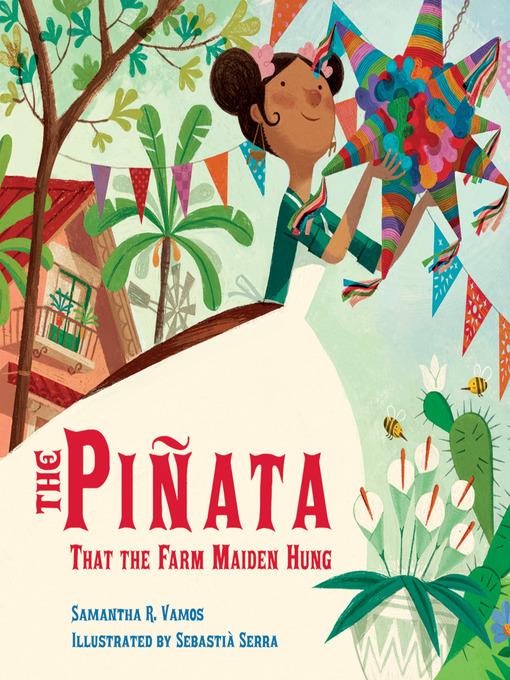
The Piñata That the Farm Maiden Hung
فرمت کتاب
ebook
تاریخ انتشار
2019
Lexile Score
600
Reading Level
2-3
ATOS
4.2
Interest Level
K-3(LG)
نویسنده
Sebastia Serraناشر
Charlesbridgeشابک
9781632896230
کتاب های مرتبط
- اطلاعات
- نقد و بررسی
- دیدگاه کاربران
نقد و بررسی

November 15, 2018
What's a birthday without a piñata? A young girl's family, along with some talented farm animals, get cracking as soon as she leaves for the market. To the traditional rhythms of "The House that Jack Built," clay is gathered, water hauled, paper shredded, etc., until all is ready for the celebration. The girl and the code-switching rhyming scheme from Vamos' The Cazuela that the Farm Maiden Stirred (illustrated by Rafael López, 2011) return for more Spanish vocabulary reinforcement. The inclusion of Oaxacan alebrijes indicates the setting is Mexico. As such, it's puzzling as to why "pasta" is used for the glue paste instead of the correct piñata-making term: "engrudo." The European term "farm maiden" is also incongruous to the setting. Barcelona-based Serra's inaccurate illustrations further the sense of inauthenticity. The characters present as Spaniards and not Mexicans, as evidenced by clothing and hats. Plain wood carvings are substituted for the fantastical alebrijes referenced in the text. Papel picado banners are depicted as pennants instead of rectangles. His piñata seems to have clay points rather than cardboard. Even the "brilliant bluebells" the caballo picks are European rather than Mexican. To add insult to injury, the glossary includes Anglicized pronunciations: "sor-PRAY-sah" instead of sor-PREH-sah for "surprise." Such lighthearted touches as the cat ferociously shredding paper cannot mitigate the book's flaws.What's meant to be a cultural celebration is, alas, culturally inaccurate. (piñata instructions, glossary) (Picture book. 4-8)
COPYRIGHT(2018) Kirkus Reviews, ALL RIGHTS RESERVED.

K-Gr 2-It takes the hard work and the imagination of many to throw a perfect surprise party. The farm maiden (campesina), a young boy, a farmer, and their group of animal friends prepare for a birthday celebration by gathering all the supplies to make a piñata for their special guest. Each character helps in its creation: The horse (caballo) hauls the water, the goose (ganso) mixes the paste, and the cat (gato) tears the paper that will become the colorful party centerpiece. The boy (niño) hangs the paper flags, while the farmer (campesino) carves traditional Mexican folk-art sculptures (alebrijes). After a long day of decorating the plaza, everyone falls asleep, forgetting to stuff the piñata with treats. But they awaken to fill it just in time as the birthday girl comes home to be surprised by all of her friends. This bilingual book written in cumulative verse poetry introduces new characters as the story unfolds, and the Spanish word for each animal replaces the English word from the previous page. The result is a colorful, festive surprise (sorpresa). Readers will enjoy singing "The Piñata Song" and will be inspired to make their own piñatas using the included recipe and instructions. A glossary of Spanish words and cultural terminology is also included. Reminiscent of a traditional folk rhyme, this book accompanies The Cazuela that the Farm Maiden Stirred, also by Lopez. VERDICT An essential addition to any picture book collection.-Natalie Romano, Denver Public Library
Copyright 1 School Library Journal, LLC Used with permission.
December 1, 2018
Grades K-2 In a familiar poetic format, award-winning Vamos amusingly illustrates how pi�atas are made, while deliberately introducing some Spanish vocabulary and Mexican culture. The story starts as a short rhythmic verse that gradually translates terms. For instance, one page reads, "This is the boy / who shaped the clay / to make the pi�ata . . ." while the subsequent verses change boy to ni�o and clay to barro?. Once the hard work of making the pi�ata is done, the family and farm animals can get down to the main event: a surprise party! Serra 's lush, warm illustrations in a saturated palette depict the enthusiastic people and animals who help make the pi�ata, which also will help readers pick up on the definitions of the Spanish words. The lively text and colorful art are engaging on their own, and the additional lessons in language and culture make this particularly useful for a classroom or group storytime. Instructions for making a pi�ata, as well as a glossary and pronunciation guide, round out this cheery, welcoming offering.(Reprinted with permission of Booklist, copyright 2018, American Library Association.)

























دیدگاه کاربران